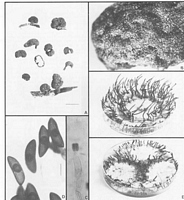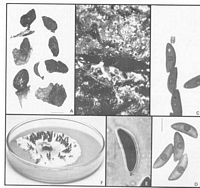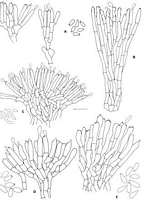|
 Xylaria tuberiformis Xylaria tuberiformis
BiostatusPresent in region - Indigenous. Endemic
Images (click to enlarge)
Caption: Fig. 4 Xylaria tuberiformis (typical form) A, Stromata (PDD 43186). B, Stromal surface
(PDD 43186). C, Ascal ring (Melzer's reagent; PDD 43186). D, Ascospores with germ slits
(Melzer's reagent, PDD 43186). E, Colonies grown on OA (top: PDD 4576 | 
Caption: Fig. 5 Xylaria tuberiformis (atypical form) A, Stromata. B, Stromal surface. C, Ascal
ring and ascospores (Melzer's reagent). D, Ascospores with germ slits (Melzer's
reagent). E, Ascospore with basal cellular appendage (Melzer's reagent, bright | 
Caption: Fig. 6 Xylaria anamorphs A, B, X. castorea (A, conidiophores and conidia from culture
PDD 44288; B, conidiophores from nature PDD 44280). C, X. cubensis (from culture,
PDD 49005). D, X. tuberiformis (typical |
Article: Berkeley, M.J. (1855). Fungi. Flora Novae-Zelandiae. Part II. Flowerless Plants. The Botany of the Antarctic Voyage II Hooker, J.D. (eds.) 378 p. 172-210, 338 London: Lovell Reeve.
Description: Sessile or shortly stipitate, subglobose, ¼ to 1/3 of an inch in diameter, pileiform; cuticle
minutely cracked, and rough with little points, not laccate; white and corky within. Perithecia
elliptic. Ostiola large, prominent. Sporidia cymbiform, 1/1000 of an inch long.
Notes: Resembling
X. piliaeformis. Berk. et Curt., but without its laccate coat, and having far larger ostiola and
sporidia. Its nearer affinities are with X. anisopleuron, Mont., and X. polymorpha; at first
sight it looks like a small Truffle.
Article: Rogers, J.D.; Samuels, G.J. (1987) [1986]. Ascomycetes of New Zealand 8. Xylaria. New Zealand Journal of Botany 24(4): 615-650 (http://www.rsnz.org/publish/abstracts.php).
Description: Stromata solitary to gregarious, subglobose to conical to subcylindrical, (2-)7-10(-40) mm
high x (2-) 7-10 mm wide, sessile and centrally attached or on minute, 1.5-4 mm long x 1
mm diam. stipes. Surface of stroma brown, plane to wrinkled and cerebriform, cracking
into polyhedral plates or not cracking; perithecia completely immersed, (400-) 600-800 µm
diam., openings obscure, minute and conical to mammiform, sometimes appearing as small
black discs against the brown of the stromal surface. Internal tissue white, solid. Asci 185-275 µm
total length x (7-)8-9.0( 12) µm, the sporiferous part (125-)140-175(225) µm,
cylindrical, 8-spored, ascospores uniseriate with overlapping ends; apical ring J+
cylindrical, 4-5(-6) µm high x (3-)4-5 µm wide. Ascospores (19.0-)22.0-25.5(-29.0) x
(5.5-)7.5-9.0 (-10.0) µm, inequilateral with one side flat to concave and the other side
round, elliptic in top view, one-celled or occasionally with an inconspicuous cellular
appendage (primary appendage) on one end; ends sometimes µmched and papillate;
transparent brown; slit (13-)15-17(-19) µm long, straight, parallel to the long axis of
the ascospore. Abnormally broad ascospores up to I 1 µm wide often seen in old
perithecia.
CHARACTERISTICS IN CULTURE: Colonies grown 2-3 weeks at 20°C in diffuse
daylight on OA 6-7 cm diam., flat, white with no blackening in the colony; mycelium
dense; stromata forming in abundance around periphery of colony and along lines of
contact between colonies derived from single ascospores. Stromata 1-4 cm long x 2-3
mm dia.m., branched or unbranched, cylindrical, acute, lacking distinctive hairs, at
first white to tan, becoming grey with conidia. Conidiophores forming a loose c. 50
µm deep palisade; branching, each branch 3-4 µm wide, terminating in a
conidiogenous cell. Conidiogenous cells (7-)10-16(-20) x (3.0-)3.5-4.0 (-4.5) µm,
straight, smooth, conidiogenous loci terminal; conidia leaving a refractive 1.0-1.5 µm
diam. frill after dehiscence. Conidia (5.5-)6.5-8.0(-10.0) x 3.0-3.5 µm, clavate to
ellipsoidal, colourless, smooth; each with a flat, refractive basal frill.
Habitat: HABITAT: Decorticated dicotyledonous wood.
Distribution: DISTRIBUTION: NORTH ISLAND: Northland, Auckland, Gisborne, Taupo,
Taranaki, Wellington. SOUTH ISLAND: Dunedin, Southland.
Notes: Xylaria tuberiformis is among the most common Xylaria species in New
Zealand. As Berkeley (in Hooker 1855) perceptively noted, this species has affinities
with X. polymorpha and X. anisopleura. It has the general stature of X. anisopleura, but
the surface usually lacks corky cracking and the germ slit is usually straight rather
than oblique or undulate. Our concept of X. tuberiformis has been reinforced by
examination of authentic material [New Zealand, Colenso no. 2098 (K)]. Although
the species is generally uniform in morphology, we have one collection (PDD 49004,
Fig. 5) with stromata that are more robust than usual. They are essentially conical, 1-2 cm high x
0.7-1.5 cm wide at the base and collapsed and split when dry. Features of
the asci, ascospores, and cultures confirmed that this is merely a morphological
variant of X. tuberiformis.
|